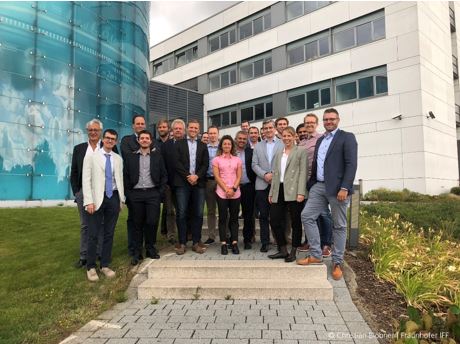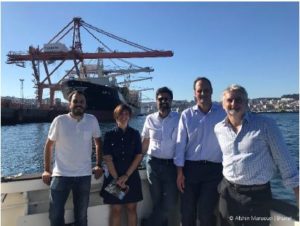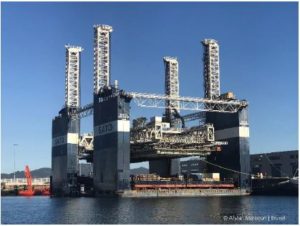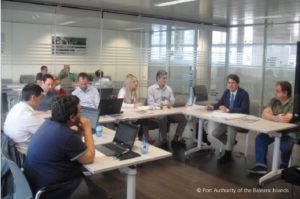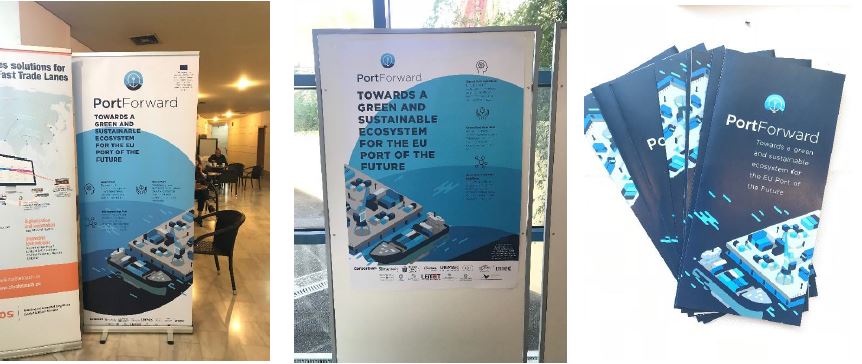
The DocksTheFuture Project aims at defining the vision for the ports of the future in 2030, covering all specific issues that could define this concept including among others, dredging, emission reduction, energy transition, electrification, smart grids, port-city interface and the use of renewable energy management. The project is a Horizon 2020 Coordination and Support Action, and consist by definition of actions consisting primarily of accompanying measures such as standardization, dissemination, awareness-raising and communication, networking, coordination or support services, policy dialogues and mutual learning exercises and studies, including design studies for new infrastructure and may also include complementary activities of strategic planning, networking and coordination between programs in different countries. The project consists of five work packages and a horizontal work package on project management.
The WP1 is focused on Port of the Future: definition of the concept to define consolidated “Port of the Future Concepts” based on preliminary activities involving stakeholders and experts. Here we have some deliverables from this work packege:
The project proposal already addressed a preliminary research on the Port of Future concept,
the definition of several Ports of the Future topics to be addressed and their related targets in
2030 and a preliminary list of projects that could be potentially clustered together with the RIA
retained proposals:
1. Port infrastructure & management;
2. Accessibility and fulfilment of EU standards;
3. Integration in supply chain & synchro modality;
4. Environmental concerns;
5. Sustainability;
6. Safety and security;
7. Digitalization;
8. Port-city relation
9. Port governance;
10. Human element;
11. Relation with neighbouring countries.
As the assessment of the inputs progressed, additional topics were added, and the need for a
classification of the various topics soon became apparent.
The following table shows the top 10 topic
assignments. Be aware that in an assessment more than one topic can be assigned.
| Number and name topic |
Number of assessments |
| T60.10: Environmental sustainability |
22 |
| T120: Governance |
13 |
| T100: Port city relations |
13 |
| T60: Sustainability |
12 |
| T10.30: Other port infrastructure |
10 |
| T40: Standards and legal instruments |
9 |
| T10.40: Hinterland connections |
9 |
| T10: Infrastructure |
9 |
| T110.20: Education and training |
8 |
| T60.20: Economic sustainability |
8 |
| T70: Safety |
8 |
| T10.60: Industrial areas |
8 |
| T10.50: Logistic areas |
8 |
| T90: Digitization, digitalization and digital transformation |
8 |
The following sections contain the main result of the assessments described by main topic.
| Topic |
T10: Infrastructure |
| Description |
This topic is about the physical infrastructure the spatial organisation of the infrastructure, about the services to maintain the infrastructure but not about the services that use the infrastructure. It also includes smart infrastructure. |
| Number of inputs |
8 |
| Input ID and name |
- 80: Unmanned ships on the horizon/Remote and autonomous ships – the next steps;
- 110: The future of ports in 2060;
- 1150: COMMISSION STAFF WORKING DOCUMENT on the implementation of the EU Maritime Transport Strategy 2009-2018;
- 1210: Sustainable port infrastructure, practical implementation of the green port concept;
- 1240: The Greening of Ports: A Comparison of Port Management Tools Used by Leading Ports in Asia and Europe;
- 1400: Socio-ecological trans;
- 1500: Securing a port’s future;
- 3250: Schipper Sustainability assessment.
|
| KPI’s |
- See also sustainability on dredging;
- Adjusted terminals to large container vessels;
- Wi-Fi network;
- Removed bottlenecks;
- Time slot allocation for trucks, night service at terminals;
- Traffic monitoring & managing;
- Industrial symbiosis;
- Land plot allocation conditions to clients;
- Recycling / circular economy focus;
- Parking zones;
- Installed ERTMS;
- Integrated lock management systems;
- Scanning technologies installed;
|
| Co-related topics |
- T60: Sustainability;
- T100: Port city relations;
- T120.10: Financing;
|
| Keywords |
- Alternative energy;
- Adaptation to changing transport modes;
- Critical infrastructure;
- Cargo Logistics systems (concepts);
|
| Gaps identified |
|
| Trends |
- Greening of energy sources, transport activities;
- Better use of existing capacity through data sharing;
- Completing TEN-T network;
- Critical Infrastructure Protection.
|
Table 7: Assessment results for topic T10 infrastructure
The TEN-T programme’s ultimate purpose is to ensure the cohesion, interconnection and interoperability of the trans-European transport network, as well as access to it. TEN-T projects, located in all EU’s Member States, covering all transport modes, had a large impact on the development of infrastructure in maritime ports areas and the connection to these areas.
Maritime port authorities, therefore, embark on various initiatives mostly related to the environmental impact of such physical projects. This is not only done on an individual basis but often situated in co-operation between ports authorities and their stakeholders.
Infrastructure:
Due to the continuous efforts of European investment plans, and the pressure of markets, ports gradually transform their infrastructure to the upcoming transport market needs.
These infrastructure works are increasingly required to align with sustainable port development models. As such they are subject to an economic cost-benefit analysis that is to evaluate both the positive (economy, society) and the negative effects (adverse social and health benefits, environment, and coastal ecosystems). Infrastructure expansion to facilitate future transport growth is to be motivated and green.
Europe’s largest ports align the construction of new container terminals, upgrading and maintenance of maritime access infrastructure, to facilitate Ultra Large Container Ship already surpassing the capacity of more than 20 000 twenty-foot equivalent unit, with 22 000 TEU ship construction orders being scheduled to be delivered as from 2019. The impact on hinterland and shore feeding connections cause a major concern to this. At times this construction of new terminals has circular economy aspects, by using contaminated sediments as the resource.
Innovations related to transport modes such driverless truck convoy platoons, Longer Heavier Vehicles (LHVs), autonomous shipping/barging, also a force to the adaptation of a ports infrastructure.
Not only the superstructure need modification. With the growing digital exchange of information and remote controlling of critical infrastructure, the EU initiated the European Programme for Critical Infrastructure Protection (EPCIP) facilitating initiatives to consider also the digital protection of the critical infrastructure (locks, bridges …).
DTLF, an initiative of the European Commission to have experts to build a common vision and roadmap for digital transport and logistics, identified as a benefit of using digital technologies a better use of the existing infrastructure by administrative simplification, optimization of cargo flows. As such the cross benefits of data sharing and more optimal use of existing infrastructure became more apparent.
Specific terminals, such as storage facilities, incorporate the flexibility to manage alternative fuels such as biogas, sourced from nearby methanation plants. Linking up to energy networks connecting industrial entities within the port area, or even with the city also is identified as an element of a future ports sustainability performance.
Environment:
Vessels are given the opportunity to offload black and grey water via tanker trucks or onto sewage water barges. Further on waste deposits infrastructures are expanded and integrated into a port’s waste management plan.
Energy:
Literature and project review identified the further deployment of alternative energy infrastructure, such as LNG for seagoing vessels, inland vessels and trucks with a view to lowering the emission caused by these transport modes.
The port area’s own energy source mix is being greenified with project examples from around the globe, such as replacing coal by LNG. Increasing investments are scheduled to expand the current shore-based power supply, and efforts taken to decrease its own energy consumption and the emission of greenhouse gasses. Growing initiatives are taken here with regards to the transparency on the related KPI’s by monitoring energy and water consumption, including indicators of urban environment quality (air quality, water, energy, and water use), by means of sustainability or similar reports.
Organisation transport:
The study related to the ‘Impact of the Development of Seaport Objective Functions for a Cargo Logistics System in Urban Areas’, details on the presented thesis that the development of the logistics-distribution function, as well as the industrial function of a seaport, leads to an increase in the flow of cargo transported by road transport with a decreasing share of rail transport. Port expansion plans nowadays are more confronted with traffic analyses, and the requirement to achieve a minimum mix of transport modes related to the new generated maritime cargo flows.
















